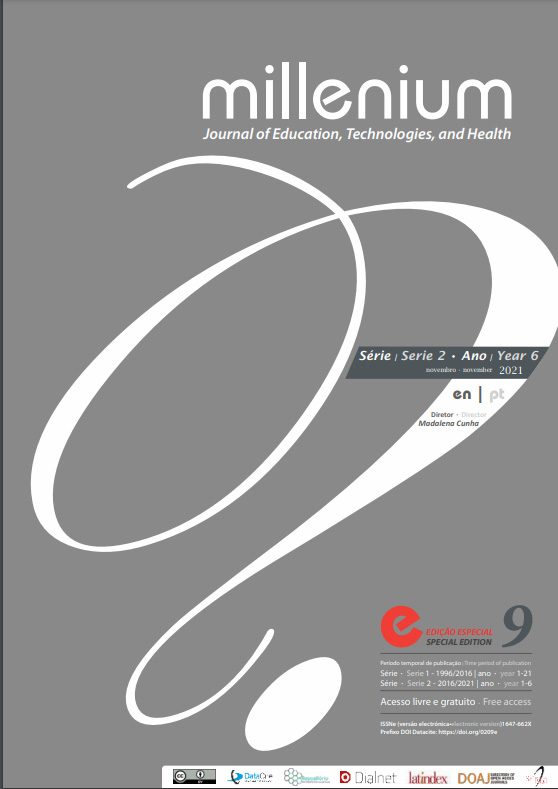Aplicação da ozonoterapia na gestão da dor e melhoria da qualidade de vida
evidências em enfermagem
DOI:
https://doi.org/10.29352/mill029e.25344Resumo
Introdução: A existência de uma dor crónica condiciona frequentemente a mobilidade e capacidade cognitiva com impacto na redução de qualidade de vida da pessoa. Neste âmbito, a ozonoterapia apresenta-se com o potencial de aliviar a dor e aumentar o bem-estar, impondo-se produzir evidências promotoras de cuidados seguros em enfermagem.
Objetivo: Analisar as evidências da utilização clínica da ozonoterapia no alívio da dor e na qualidade de vida.
Métodos: O estudo exploratório, de caráter descritivo com foco transversal e retrospetivo, incluiu 31 pessoas submetidas a ozonoterapia maioritariamente do sexo feminino (61,3%) com uma média de idades de 54 anos (±16,0). Como instrumento de recolha de dados foram utilizados a escala EVA para mensuração do nível de dor e o questionário EQ-5D para avaliação do nível de qualidade de vida autopercebido. O estudo obteve parecer favorável da Comissão de Ética do Instituto Politécnico de Viseu (IPV) (N.º 15/SUB/2021) no dia 25 de março de 2021 e autorização para a recolha de dados do dirigente da instituição de saúde, que decorreu de 01 de Abril a 30 de Junho de 2021.
Resultados: A evolução temporal da dor (início, 1.º mês, 2.º mês e 3.º mês) revela uma redução gradual dos níveis de dor. A obtenção de perfis de qualidade de vida com ausência de problemas após um período de tratamento com ozonoterapia foi de 29% (n=9). A idade é uma variável com impacto significativo nos níveis de dor, sendo os participantes com mais idade, mais afetados por níveis mais elevados de dor em todas as fases do estudo. A presença de comorbilidades tem impacto na qualidade de vida no domínio dos cuidados pessoais e das atividades habituais. A idade tem igualmente influência na obtenção de perfis de qualidade de vida sem problemas, sendo estes perfis menos frequentes nas idades mais avançadas. O género revela não ser uma variável com influência a nível da dor ou da qualidade de vida.
Conclusão: A ozonoterapia diminui os níveis de dor e melhorou a qualidade de vida, contudo, dado o baixo n amostral, torna-se necessário replicar o estudo em amostras mais alargadas e com entidades nosológicas diversificadas para validar as mais valias desta intervenção terapêutica.
Downloads
Referências
António, C.A.S.; Santos, E.J.F.; Cunha, M.; & Duarte, J.C. (2019). Estudo psicométrico da Escala de Práticas de Enfermagem na Gestão da Dor. Revista de Enfermagem Referência, , IV (22), 51 - 62. https://doi.org/10.12707/RIV19039
Burckhardt, C. S., & Anderson, K. L. (2003). The Quality of Life Scale (QOLS): reliability, validity, and utilization. Health and quality of life outcomes, 1, 60. https://doi.org/10.1186/1477-7525-1-60
Cavassan, N., Camargo, C. C., de Pontes, L. G., Barraviera, B., Ferreira, R. S., Miot, H. A., Abbade, L., & Dos Santos, L. D. (2019). Correlation between chronic venous ulcer exudate proteins and clinical profile: A cross-sectional study. Journal of proteomics, 192, 280–290. https://doi.org/10.1016/j.jprot.2018.09.009
Delgado, D. A., Lambert, B. S., Boutris, N., McCulloch, P. C., Robbins, A. B., Moreno, M. R., & Harris, J. D. (2018). Validation of Digital Visual Analog Scale Pain Scoring With a Traditional Paper-based Visual Analog Scale in Adults. Journal of the American Academy of Orthopaedic Surgeons. Global research & reviews, 2(3), e088. https://doi.org/10.5435/JAAOSGlobal-D-17-00088
Donnelly, S. C. (2016). Chronic disease and assessing quality of life? QJM: An International Journal of Medicine, 109(11), 701-701. https://doi.org/10.1093/qjmed/hcw205
Elvis, A. M., & Ekta, J. S. (2011). Ozone therapy: A clinical review. Journal of natural science, biology, and medicine, 2(1), 66–70. https://doi.org/10.4103/0976-9668.82319
Esteves, E. S. (2017)- Eficácia da ozonoterapia tópica na redução da carga bacteriana e tempo de cicatrização em úlceras de etiologia venosa dos membros inferiores; Dissertação de Mestrado. Escola Superior de Saúde de Viseu. http://hdl.handle.net/10400.19/4533>.
EUROQOL RESEARCH FOUNDATION - EQ-5D-5L – About, atual. 2019.
FERRETTI, Fatima et al. - Quality of life in the elderly with and without chronic pain. Brazilian Journal Of Pain. . ISSN 2595-0118. 2018). doi: 10.5935/2595-0118.20180022.
Franzini, M., & Ionita, G. (2017). Possibility of oxygen-ozone therapy in the geriatric patient. Ozone Therapy, 1(3), 53-55. https://doi.org/10.4081/ozone.2016.6471
Lorente, S., Viladrich, C., Vives, J., & Losilla, J.-M. (2020). Tools to assess the measurement properties of quality of life instruments: a meta-review. BMJ Open, 10(8), e036038. https://doi.org/10.1136/bmjopen-2019-036038
Megari K. (2013). Quality of Life in Chronic Disease Patients. Health psychology research, 1(3), e27. https://doi.org/10.4081/hpr.2013.e27
SANTOS, J. L. P. dos (2016). Necessidades formativas dos enfermeiros portugueses em ozonoterapia; Dissertação de Mestrado. Instituto Superior de Educação e Ciências de Lisboa. http://hdl.handle.net/10400.26/21816>.
Shofany, C. (2017). Quality of life among chronic disease patients. Nursing & Care Open Acces Journal, 4(2), 385-394. DOI: 10.15406/ncoaj.2017.04.00103
van Hecke, O., Torrance, N., & Smith, B. H. (2013). Chronic pain epidemiology - where do lifestyle factors fit in? British journal of pain, 7(4), 209–217. https://doi.org/10.1177/2049463713493264
WHO - WHO | WHOQOL: Measuring Quality of Life. Health statistics and information systems (WHO). 2020).
Downloads
Publicado
Como Citar
Edição
Secção
Licença

Este trabalho encontra-se publicado com a Licença Internacional Creative Commons Atribuição 4.0.
Os autores que submetem propostas para esta revista concordam com os seguintes termos:
a) Os artigos são publicados segundo a licença Licença Creative Commons (CC BY 4.0), conformando regime open-access, sem qualquer custo para o autor ou para o leitor;
b) Os autores conservam os direitos de autor e concedem à revista o direito de primeira publicação, permitindo-se a partilha livre do trabalho, desde que seja corretamente atribuída a autoria e publicação inicial nesta revista.
c) Os autores têm autorização para assumir contratos adicionais separadamente, para distribuição não-exclusiva da versão do trabalho publicada nesta revista (ex.: publicar em repositório institucional ou como capítulo de livro), com reconhecimento de autoria e publicação inicial nesta revista.
d) Os autores têm permissão e são estimulados a publicar e distribuir o seu trabalho online (ex.: em repositórios institucionais ou na sua página pessoal) já que isso pode gerar alterações produtivas, bem como aumentar o impacto e a citação do trabalho publica
Documentos necessários à submissão
Template do artigo (formato editável)





